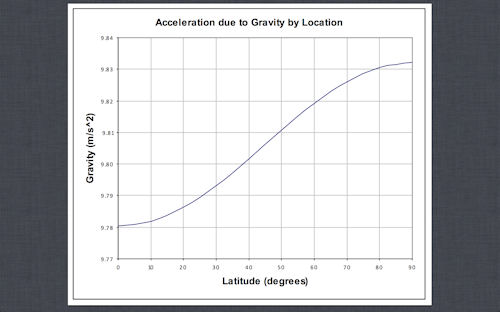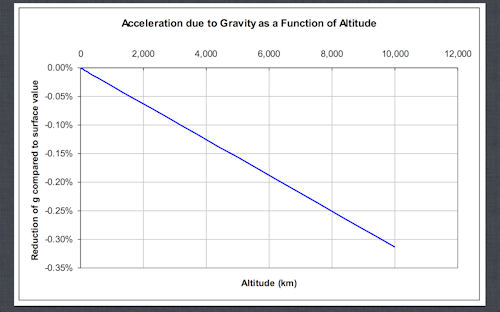Latest News
August 1, 2012
By Mike Baker
The calibration accuracy of many sensors is dependent on the force of gravity at the site of operation. The sensitivity of accelerometers, inclinometers, force transducers and load cells is proportional to the force of gravity where they are being used. Their absolute sensitivity may differ when in use somewhere other than where they were manufactured. The gravity across the Earth’s surface may translate to a variation of up to 0.5%, depending on where in the world it is measured.
For example, electronic weigh scales that use load cells as weight sensors measure the force of gravity acting upon a mass. If on-site gravity compensation is not taken into consideration, the scales will have an error proportional to the difference in gravitational acceleration between the installation and calibration sites.
Universal Laws
Sir Isaac Newton’s Law of Universal Gravitation stated that: “Every point mass attracts every other point mass by a force pointing along the line intersecting both points. The force is proportional to the product of the two masses, and inversely proportional to the square of the distance between them.” Mathematically, the force due to gravity is expressed by the formula: F = Gm1m2/r2, where F is the force between masses, G is the Gravitational Constant, m1 and m2 are the first and second masses, and r is the distance between the centers of the masses.
Although Einstein’s Theory of General Relativity has since superseded this law, it continues to be applied, unless there is a need for extreme precision or when dealing with gravitation for extremely massive and dense objects.
The Gravitational Constant G is actually very difficult to measure, but in 2010, the Committee on Data for Science and Technology (CODATA) recommended the value of G = 6.67384 x 10-11 m3 kg-1 s-2, with an uncertainty of one part in 8,300. Thus, with knowledge of the mass of Earth and its radius, the force due to gravity can be ascertained.
The Law of Universal Gravitation defines a mass as a point mass; Earth is neither of uniform shape nor even mass distribution. Indeed, Earth is also not spherical, but actually takes the form of an oblate spheroid, the equatorial diameter being larger than that at the poles. Gravity, therefore varies in proportion to latitude (see Figure 1).
 |
| Figure 1: The Earth’s gravity varies in proportion to latitude, which can affect sensor measurements. |
Secondly, the height above sea level of the Earth’s surface varies according to location. Consequently, the acceleration is proportional to altitude, too (see Figure 2).
 |
| Figure 2: Gravity, and therefore its impact on sensor measurements, also changes with altitude. |
Thirdly, Earth is spinning on its axis—and consequently, the force of gravity at the Equator is reduced by the centripetal force, the effect diminishing to zero at the poles.
By way of example and using the Law of Universal Gravitation, the force due to gravity acting on a mass of 1kg, at sea level and at the Equator, is 9.7958N. However, at an elevation of 2,000m, the force reduces to 9.7897, a reduction of 0.06%. Similarly, due to Earth’s geometry, the force acting on a mass of 1kg at the poles increases by 0.70% compared to that at the Equator.
Complicating matters further is the effect of centripetal acceleration due to Earth’s rotation that varies from a maximum at the Equator to zero at the poles. Varying according to latitude, this reduces the apparent force due to gravity at the Equator by 0.35%, compared to that at the poles.
What It All Means
The application of force transducers in relation to weighing is perhaps the easiest to relate to when reaching an understanding of the effects of gravity on sensor calibration and accuracy. Typically, a weighing instrument is calibrated using test masses. But as has been shown, the forces produced by test masses will vary according to location—and it is commonplace for accurate weighing systems to have a means of adjustment built in to allow for multi-location deployment throughout the world.
Inertial inclinometers and accelerometers also use gravity as their fundamental calibration reference, but it is important to note that the calibration will only be truly valid when the sensors are used at the original calibration site.
When making accurate measurements, and unless the sensors can be calibrated locally, it is essential to consider the latitude and the altitude at which the sensors will be installed, and adjust the sensitivity of the sensors accordingly if the manufacturer’s calibration data is to be the sole source of reference.
Fortunately, there are several sources of gravitational data available for reference that may be used for this purpose. One is on the website of Physikalisch-Technische Bundesanstalt (PTB), the German metrology institute providing scientific and technical services: PTB.de/cartoweb3/SISproject.php.
The use of a value for g of 9.81m/s2 is commonplace, but when high accuracy is required from a sensor that is reliant upon gravity for its function, it is important to correct for variations in gravity between the original calibration site and that where the sensors are installed. Sensor manufacturers should always provide users with the value of g at the calibration site so that variations can be taken into consideration.
Mike Baker is managing director of Sherborne Sensors. His knowledge and experience within the engineering and sensors field spans more than 40 years. Contact him via de-editors@deskengcom.
More Info
Sherborne Sensors
Subscribe to our FREE magazine, FREE email newsletters or both!
Latest News
About the Author
DE’s editors contribute news and new product announcements to Digital Engineering.
Press releases may be sent to them via [email protected].





